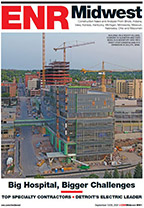Summer may be high season for construction, but contractors in the Midwest have lowered their sights this year due to the lingering effects of recession in the region.


Rather than improve, as many economists predicted, conditions have worsened this year, with U.S. construction spending falling for the sixth consecutive month in May to an 11-year low, according to the U.S. Census Bureau.
“I've had to scale back my optimism,” says Ken Simonson, chief economist with the Arlington, Va.-based Associated General Contractors of America. “I knew we'd be wrapping up some major federal initiatives this year, but despite signs of life in manufacturing, warehouse and hospital construction, the private-office and retail sectors remain very depressed. Commercial spending just hasn't been sufficient to offset sectors that are dead in the water.”
“That's really the story to watch for the next one to two years—whether privately funded construction will offset declines in public spending,” says Anirban Basu, chief economist with the Associated Builders and Contractors of America in Arlington, Va.
The shortfall is reflected in flat to falling revenues at firms ranked in ENRMidwest's annual listing of the region's top contractors. Even the region's largest firms faltered, with the top 20 collectively logging revenues of $8.6 billion in 2010, a 23% decline from $11.2 billion in 2009. Of those firms, only six, including Clayco Inc., Gilbane Building Co., F.A. Wilhelm, Miron Construction, Industrial Contractors Inc. and Bulley & Andrew LLC, showed positive growth last year.
Although ABC data showed rising commercial backlogs during the first quarter of 2011, many projects, including offices and hotels, have since been put on hold due to disappointing economic data and rising material costs. “In many ways, 2011 is shaping up to be a replay of 2010,” says Basu. “Both years showed good economic momentum through April, followed by deceleration in the spring. In 2010, the economy picked up again later in the year, much as we expect it will this year, assuming rising fuel and food costs are temporary.”
Recovery Not Translating Into Work
As the U.S. economy goes, so goes the Midwest. “More so than other regions, the national and global economies define the Midwest's performance because its industrial base supplies so much product to other regions,” says Basu.
Just as the Midwest experienced a sharp decline in 2008 when automakers, retailers and others found inventories rising too sharply, the region has since enjoyed a more robust rebound than service-oriented regions after the early stages of the recovery increased the need for companies to replenish inventories. “By late 2009, orders began to pick up, so from a cyclical standpoint, the Midwest has come back stronger than many realize,” says Basu.
Nevertheless, increases in inventories have yet to translate into a significant uptick in construction in the region, where average backlogs were the lowest—6.21 months—of any U.S. region during the first quarter of 2011, according to ABC. Likewise, construction employment has yet to rebound, with the U.S. Census Bureau reporting only modest seasonal gains in Illinois, Indiana, Missouri and Ohio in May. Wisconsin showed losses of 6% for the same period.
“Different states are in different phases of the recovery cycle,” says Basu. “Wisconsin's industrial base, which includes food and beverages, suffered a considerable downturn during the recession. Indiana's downturn was more severe but occurred earlier.”
In major metro areas, only Chicago has seen a notable uptick in construction employment, some 1,700 new jobs in April, though those gains were offset by declines elsewhere in Illinois, according to AGC.
The regional figures match up with national data showing construction unemployment rising in many major metro regions as infrastructure investment in those areas wanes.







Post a comment to this article
Report Abusive Comment